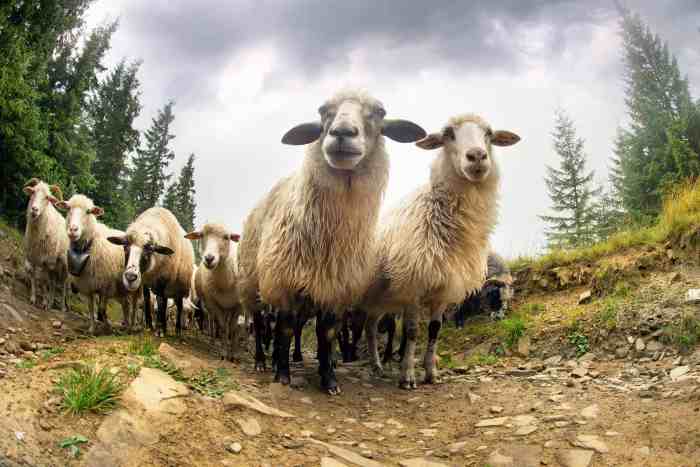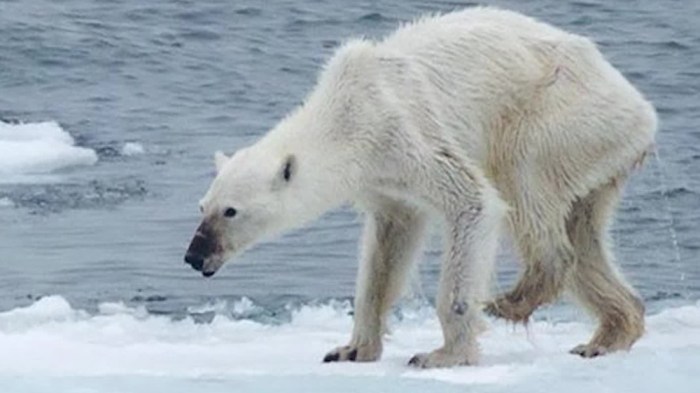
Dive into the world of Animals and climate change impact where we explore how climate change disrupts habitats, alters migration patterns, and threatens species with extinction. Get ready for a wild ride!
As we embark on this journey, we’ll uncover the intricate relationship between climate change and its profound impact on animal life.
Animals and Climate Change Impact
Climate change has a significant impact on animal habitats, leading to changes in temperature, precipitation, and overall ecosystem balance. These changes can disrupt the availability of food and water, as well as alter breeding and migration patterns for many species.
Effects on Animal Habitats
- Increasing temperatures can lead to the loss of important habitats, such as coral reefs, wetlands, and forests, threatening the survival of many species.
- Changes in precipitation patterns can result in droughts or floods, affecting the availability of food and water for animals.
- Rising sea levels due to melting ice caps can flood coastal habitats, displacing animals and disrupting their ecosystems.
Impact on Animal Migration
- Changing weather patterns can alter the timing and routes of animal migration, affecting their ability to find food, mate, and raise offspring.
- Warmer temperatures can cause some species to migrate to higher altitudes or latitudes in search of cooler climates, leading to conflicts with other species.
- Migration routes may become more hazardous due to extreme weather events, putting animals at risk of exhaustion, starvation, or predation.
Correlation with Animal Extinction
- Climate change is considered a significant factor contributing to the acceleration of animal extinction rates, as habitats become unsuitable for many species.
- Loss of biodiversity due to extinction can disrupt ecosystems and food chains, impacting other species and overall ecosystem health.
- Conservation efforts are crucial in mitigating the effects of climate change on animal populations and preventing further extinctions.
Animals Livestock

Livestock farming plays a significant role in the environmental impact on climate change. The production of meat, dairy, and other livestock products contributes to greenhouse gas emissions, deforestation, water pollution, and biodiversity loss.
Environmental Impact of Livestock Farming
Livestock farming is a major contributor to climate change due to the release of methane and nitrous oxide gases. Methane is produced during the digestive process of ruminant animals like cows and sheep, while nitrous oxide is released from manure and fertilizers used in feed production. These gases have a much higher impact on global warming compared to carbon dioxide.
- Livestock farming is responsible for about 14.5% of global greenhouse gas emissions, according to the Food and Agriculture Organization of the United Nations.
- The clearing of forests for pastureland and feed crops leads to deforestation, which further exacerbates climate change by reducing the number of trees that can absorb carbon dioxide.
- Water pollution is another consequence of livestock farming, as manure and chemicals from feed crops can run off into waterways, contaminating freshwater sources.
Traditional vs Sustainable Livestock Farming
Traditional livestock farming practices often involve intensive confinement, the use of antibiotics and hormones, and feed sourced from deforested lands. In contrast, sustainable practices focus on animal welfare, reducing greenhouse gas emissions, and preserving natural resources.
- Sustainable livestock farming includes rotational grazing, where animals are moved to different pastures to prevent overgrazing and soil degradation.
- Organic farming methods avoid synthetic pesticides and fertilizers, promoting soil health and biodiversity on the farm.
- Agroforestry systems integrate trees and livestock, providing shade for animals, improving soil fertility, and sequestering carbon from the atmosphere.
Role of Livestock in Greenhouse Gas Emissions
Livestock contribute to greenhouse gas emissions through enteric fermentation, manure management, feed production, and land-use change. The shift towards sustainable livestock farming practices is essential to reduce the environmental impact of livestock on climate change and promote a more sustainable food system.
Wild Animals
Climate change has a significant impact on the behavior and survival of wild animals. As temperatures rise and habitats change, many species are forced to adapt or face extinction. Deforestation, driven largely by human activities, further exacerbates the challenges faced by wild animals.
Impact of Climate Change on Wild Animals
- Rising temperatures disrupt migration patterns and breeding cycles of wild animals.
- Changes in weather patterns lead to food scarcity and water shortages, affecting the survival of many species.
- Increased frequency of extreme weather events, such as hurricanes and wildfires, pose direct threats to wild animal populations.
Impact of Deforestation on Wild Animal Populations
- Deforestation destroys natural habitats, leading to loss of biodiversity and displacement of wild animals.
- Fragmentation of forests isolates populations, making it difficult for species to find mates and maintain genetic diversity.
- Illegal logging and land clearing for agriculture further endanger wild animal populations and disrupt ecosystems.
Conservation Efforts for Protecting Wild Animals
- Establishment of protected areas and wildlife reserves to safeguard habitats for endangered species.
- Implementation of sustainable forestry practices to reduce deforestation and promote habitat conservation.
- Collaboration between governments, NGOs, and local communities to address climate change impacts on wild animals.
Conclusion

In conclusion, Animals and climate change impact shed light on the urgent need to address environmental issues to safeguard the future of our animal counterparts. Let’s join hands to protect and preserve their habitats for generations to come.
FAQ Explained
How does climate change affect animal migration?
Changing weather patterns disrupt traditional migration routes, forcing animals to adapt or face challenges in finding food and suitable habitats.
What is the environmental impact of livestock farming on climate change?
Livestock farming contributes to greenhouse gas emissions, deforestation, and water pollution, impacting climate change on a global scale.
How can we protect wild animals from the effects of climate change?
Conservation efforts focus on preserving habitats, combating deforestation, and raising awareness to mitigate the impact of climate change on wild animal populations.





